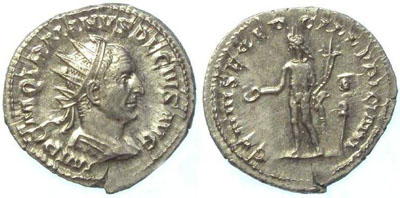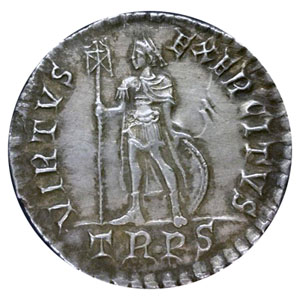Neil S Berman - Expert Numismatist & Silver Coin Dealer
Silver Coins Trade through History
Roman Silver Coins
 Roman coinage was issued in great quantities wherever the Romans conquered, which was as north as Britain, northern Gaul in what is now Germany, the Spanish peninsula, and most of what is now the Middle East and North Africa and their coins are found in hoards all over their former territories even to today. The denarius remained an important Roman coin until the Roman economy began to crumble. As Rome declined so did her coinage. By and during the 3rd century CE, the Antoninianus was minted in quantity. This was originally a "silver" coin with low silver content, but developed through stages of debasement, sometimes to the point of a silver wash (silver plate) onto pure bronze coins.
Roman coinage was issued in great quantities wherever the Romans conquered, which was as north as Britain, northern Gaul in what is now Germany, the Spanish peninsula, and most of what is now the Middle East and North Africa and their coins are found in hoards all over their former territories even to today. The denarius remained an important Roman coin until the Roman economy began to crumble. As Rome declined so did her coinage. By and during the 3rd century CE, the Antoninianus was minted in quantity. This was originally a "silver" coin with low silver content, but developed through stages of debasement, sometimes to the point of a silver wash (silver plate) onto pure bronze coins.
 Although many regions ruled by Hellenistic monarchs were brought under Roman control, this did not immediately lead to a unitary monetary system throughout the Mediterranean region. Local coinage traditions in the eastern regions prevailed, while the denarius dominated the western regions. Apart from the Greeks and the Romans, also other peoples in the Mediterranean region issued coins. These include the Phoenicians, the Carthaginians, the Jews, the Celts and various regions in the Iberian Peninsula and the Arab Peninsula.
Although many regions ruled by Hellenistic monarchs were brought under Roman control, this did not immediately lead to a unitary monetary system throughout the Mediterranean region. Local coinage traditions in the eastern regions prevailed, while the denarius dominated the western regions. Apart from the Greeks and the Romans, also other peoples in the Mediterranean region issued coins. These include the Phoenicians, the Carthaginians, the Jews, the Celts and various regions in the Iberian Peninsula and the Arab Peninsula.
In regions to the East of the Roman Empire that were formerly controlled by the Hellenistic Seleucids, the Parthians created a kingdom in Persia. The Parthians issued a relatively stable series of silver drachms and tetra drachms. After the Parthians were overthrown by the Sassanians in 226 CE, the new dynasty of Persia began the minting of their distinct thin, spread fabric silver drachms, which became a staple of their empire right up to the Arab conquest in the 7th century CE.